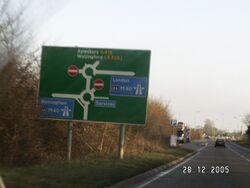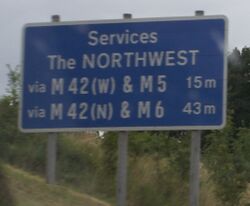Planning service area locations

Some of the most famous (and indeed infamous) motorway services in the country are positioned at difficult roundabouts. The operator normally gets the blame for this, and occasionally they deserve it, but most of the time they are innocent.
Until 1992, motorway service area locations were chosen by the government. There was no rule that they had to be built online, but they usually were. They were planned at intervals roughly every 15 miles (skipping every other service area if it was a quiet road). The precise location would be studied in detail, considering how much disturbance would be caused and how pleasant a site it would make.
As services became larger and motorways became more contentious, planning services became more of an art. Motorways were opening around the rural-urban fringe where there were frequent junctions and plenty of irate neighbours. Local councils became much more obstructive. In addition, developers were falling out of love with the whole idea, so the government tried to keep them sweet by choosing profitable locations. These factors all combined to cause many motorways like the M25 and M42 to open without enough services, and to cause services to be proposed in totally unsuitable locations such as Gordano, South Mimms, Tamworth and Birchanger Green, which are all offline services. At Cherwell Valley, the local council had been pushing for that location for 10 years before it was built, as they knew it involved the least work.
Highway engineers genuinely seemed to believe that if they had several major roads, a few local turnings and a service area all arranged around the same roundabout, it would keep everybody happy by avoiding the need for multiple buildings or big, expensive flyovers. Which it did, for a few years, until these roundabouts became congested and have been a nightmare ever since.
By 1992, developers were totally responsible for planning service area locations. Developers favoured smaller, profitable locations at existing junctions, as did the planning authorities. The new policy was supposed to encourage more frequent, smaller services. A minimum distance of 15 miles was specified.
In 2013, the absolute minimum distance was abolished. Two rival service stations can in theory now be built opposite each other, if they can both get planning approval.
On A-roads, planning services has always been down to the private sector, with no joined-up planning process.
In Ireland, online services are planned by the state while offline services are planned by the private sector.
Areas With No Services

Over time, the planning system has resulted in some significant lengths of motorway having no services. Government guidance has generally been to keep services no more than 28 miles apart on any motorway route, but there have been some notable exceptions:
- There was a famous sign on the M4 westbound approaching Heston, which said "last services for 106 m". This was measured to Aust, but the motorway wasn't complete at the time. It was later changed to 82 miles, and remained that way for a while as there was a debate about what to do in the Reading area.
- The M42 acts as a link road between several key motorways: the M5, M6, M40 and ultimately the M1. While some services were eventually provided on the road, the core section between the M40 and M6 remains without any. This creates a 48 mile gap between Warwick and Hilton Park - though there is an alternative route with more services. Services in the Solihull area were debated before the road was built and continue to be debated to this day.
- When the M25 was a rushed job and in many respects it wasn't well planned. When it was completed in 1986, it had just one half-built service area covering the whole 118 mile route. The gap was never truly plugged until Cobham opened in 2012.
- The M40 was completed in 1991. Linking the M25 and the M42, it combined both of the problems above into one mega-problem. It was now possible to drive from Maidstone to Telford, a journey of about 200 miles, without passing any services at all. This issue received political attention, as it was used to justify deregulating the industry. Cherwell Valley opened in 1994, with Beaconsfield filling the final gap on the M40 in 2009.
- The A1(M) through North Yorkshire is the only significant length of motorway to open since the government stopped planning motorway services, with the first phase opening in 2009. As it is an upgrade to the existing A1, its construction involved actively taking away existing facilities. Local objections mean the planning system has been slow to replace them: it is 63 miles from Barnsdale Bar to Scotch Corner, with only Wetherby, and Leeming Bar and Ferrybridge (both of which require a diversion) in between.
Closest Services
Lymm and Knutsford on the M6, which are 5.1 miles apart (or 6.3 including the junction). If you disqualify Lymm for being a truckstop, then the answer will be at the far end of the M4: Pont Abraham and Swansea are 6.2 miles apart (or 6.7 including the roundabouts).
There are many examples of signposted A-road services which are only one mile apart, such as Solstice and Countess on the A303, or Birchanger Green and Stansted on the A120.